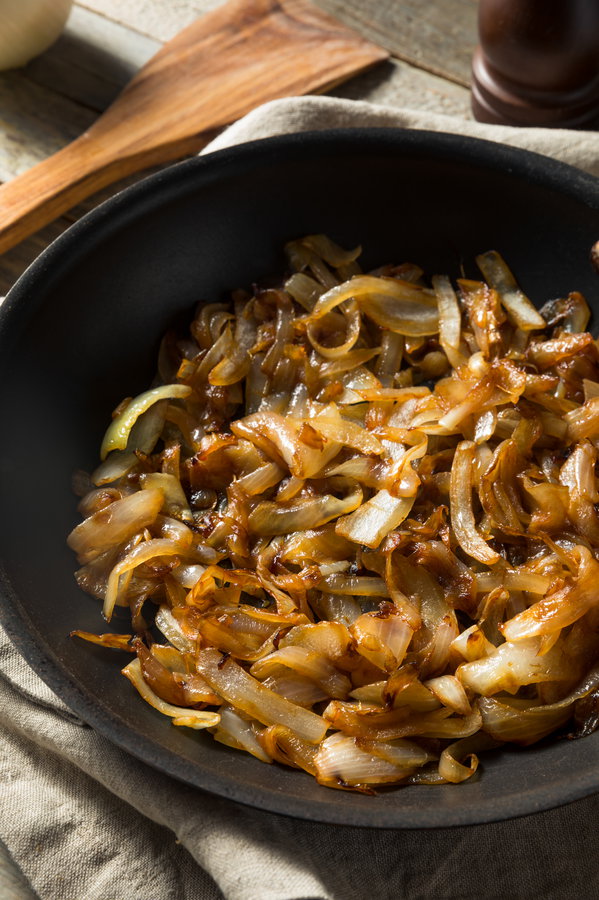
Onions are a staple in many kitchens worldwide, renowned for their unique ability to impart a savory, umami-rich flavor to dishes. But when you transform these pungent bulbs via the alchemy of heat and time, you unlock a sweeter, more complex side to their nature. Yes, we’re talking about caramelized onions – an ingredient that is pure magic, capable of transforming dishes into something extraordinary. Today, we’ll be delving into the art of caramelizing onions, and I’ll be sharing some fantastic ways to utilize them in your culinary endeavors.
How to Caramelize Onions
Caramelizing onions is not difficult, but it requires patience. This slow-cooking process mellows the onions’ sharpness, allowing them to release their natural sugars and develop a sweet, rich flavor and a tender, silky texture.
Ingredients:
4 large onions (yellow onions are a classic choice)
2 tablespoons of olive oil or unsalted butter
Salt
A splash of water or broth, as needed
Instructions:
Preparation: Peel your onions and slice them thinly. For a nice, melting texture, you can slice the onions pole to pole (from stem end to root end) into thin, even strips.
Sauté: Heat the olive oil or butter in a large, heavy-bottomed pan over medium heat. Add the onions, stirring them around to coat evenly with the oil or butter.
Cook Slowly: Reduce the heat to low and let the onions cook slowly. This is the key to caramelization – it’s a process that can’t be rushed. Stir the onions every few minutes to prevent them from sticking and burning.
Season: After the onions have been cooking for about 10 minutes, sprinkle a pinch of salt over them. This helps draw out moisture, enhancing the caramelization process.
Monitor and Deglaze: After about 30 minutes, the onions should start to brown. If they’re browning too quickly, you can add a splash of water or broth to the pan and scrape up any brown bits stuck to the bottom – this is called deglazing. These bits add extra flavor to the caramelized onions.
Patience is Key: Continue to cook the onions, stirring occasionally and deglazing as needed, until they are deeply browned, soft, and sweet. This could take anywhere from 45 minutes to 1 hour.
And voilà! You now have caramelized onions. The whole process requires a bit of patience, but the result is definitely worth it. Now, let’s dive into some ways to use this culinary delight.
Tasty Ways to Use Caramelized Onions
Pizza and Flatbreads: Caramelized onions are a wonderful topping for pizzas and flatbreads, especially when paired with cheese. Try them on a classic pizza with goat cheese and spinach, or on a flatbread with brie and prosciutto.
Pasta Dishes: Stir caramelized onions into pasta dishes for a rich, sweet twist. They work particularly well in creamy pasta sauces or tossed with spaghetti, olive oil, and Parmesan.
Sandwiches and Burgers: Upgrade your sandwiches and burgers by adding a spoonful of caramelized onions. They complement a range of fillings, from roast beef and Swiss cheese to turkey and cheddar.
Soups and Stews: Incorporate caramelized onions into your soups and stews for added depth of flavor. They’re an essential ingredient in classic French onion soup, but also work well in a variety of other dishes like beef stew or a hearty lentil soup.
Dips: Blend caramelized onions into dips for a sweet, savory note. They are the key ingredient in classic French onion dip, but also work wonders in hummus, ricotta, or cream cheese-based spreads.
Grain Bowls and Salads: Give your grain bowls or salads a sweet and savory twist by adding caramelized onions. They pair well with quinoa, farro, and all kinds of leafy greens.
Quiches and Tarts: Caramelized onions are fantastic in egg-based dishes like quiche, frittata, and tarts. Try a classic quiche Lorraine with a layer of caramelized onions at the bottom, or a savory tart with goat cheese and caramelized onions.
Roasted Vegetables: Caramelized onions can be mixed with other roasted vegetables to add a touch of sweetness and depth of flavor. Try mixing them with roasted brussels sprouts, carrots, or sweet potatoes.
Stuffings and Dressings: Whether for poultry or vegetables, caramelized onions add a burst of flavor to stuffings. They’re also a fantastic addition to dressings for a sweet-and-savory vinaigrette.
Mashed Potatoes or Cauliflower: Stir some caramelized onions into your mashed potatoes or cauliflower for an elevated side dish.
Caramelized onions, with their rich, deep flavor, can enhance a wide variety of dishes, adding a gourmet touch to even the simplest meals. Once you’ve mastered the art of caramelizing onions, you’ll discover their versatility and find yourself turning to this ingredient often to add a touch of magic to your cooking. Happy caramelizing!

Leave A Comment